James Dunham
James C. Dunham was a mass murderer who, on the night of May 26, 1896, killed his wife, her family, and two of that family's servants in Campbell, California. He disappeared during the intense, ensuing manhunt and never has been positively identified since then.
James Dunham | |
|---|---|
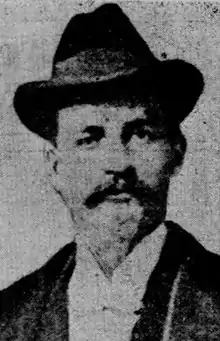 | |
| Born | James C. Dunham |
| Spouse | Hattie Wells Dunham |
| Children | 1 |
| Details | |
| Date | May 26, 1896 |
| Location(s) | Campbell, California, United States |
| Target(s) | Family |
| Killed | 6 |
| Weapons | Axe .38-caliber revolver .45-caliber revolver |
Background
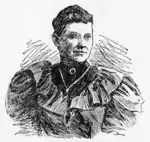
Ada Wells had been a schoolteacher; her husband Oscar C. Wells, retired from military service, had come to California in 1867 for his health and died in 1883.[1] They owned the orchard in Campbell. She remarried to McGlincy in approximately 1889 or 1890.[1][2]
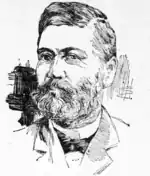
Colonel Richard McGlincy arrived in California approximately in 1888[1] and held several public offices there, including Deputy Assessor of Santa Clara County, after retiring from service in the Confederate Army. He lived on the 54-acre (22 ha) orchard approximately 1+1⁄2 mi (2.4 km) south of Campbell with his wife, Ada Wells, her two adult children, Hattie and James, and several servants.[3]
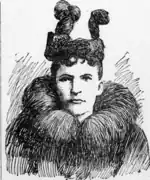
His stepdaughter, Hattie Wells, once was engaged to be married to Charles Dunham, the younger brother of James Dunham. However, she married James instead in 1895 and they lived together with McGlincy.[3] She was a graduate of the California State Normal School[4] and recently had given birth to their son Percy Osborne on May 4.[5]
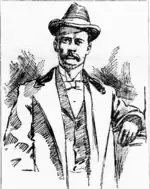
James Dunham was not highly regarded; at the time of his marriage to Hattie, he was undergoing a divorce from a young lady with whom he had eloped recently.[6] After the murders, newspapers asserted he "[had] done nothing toward the support of his wife" since their marriage; contemporary coverage noted he had started a short-lived bicycle business in Stockton and worked as a foreman in his father-in-law's fruit orchards.[3] The couple were both bicyclists, having ridden together from Stockton to Sacramento in August 1895. In Sacramento, after Hattie's jewelry was stolen, investigators concluded that Dunham had pawned the items while she slept.[7] Most recently, he had enrolled at Santa Clara College aged 30,[8] enrolling in a four-year course in the classics starting in February 1896, with the stated intention to pursue a career in law afterwards.[3]
Murders in May
On Monday, May 25, Dunham withdrew his life's savings from the bank, approximately $1,000, and the next day hid a bicycle in the brush by the dry creek bed, a few hundred yards from the house. Contemporary news coverage called these actions premeditation.[8]
May 26–27, 1896
Using an axe and two revolvers, Dunham murdered six people that night:[3][9]
- Hattie Wells Dunham (26), his wife
- Minnie Schlesser (28), a household servant
- Ada Wells McGlincy (53), his mother-in-law
- James Wells (22), his stepbrother-in-law
- Robert Brisco (30), a household servant
- Colonel Richard Parran McGlincy (56), his stepfather-in-law[10][11]
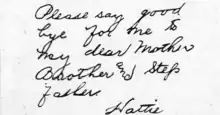
On the night of May 26, Col. McGlincy left the house for a few hours to attend a meeting of the American Protective Association[4] with his stepson, James Wells, and one of the farmhands, George Schaible.[3] Investigators believe that Dunham did not arrive until around 10 PM that night,[4] when the remaining occupants were getting ready for bed. First, he gagged and strangled his wife, Hattie Wells, then killed the servant Minnie Schlessler with an ax blow to the head as she rushed in from her adjoining room upon hearing the racket.[3][4] A holographic note was found next to Hattie's bed, which read "Please say good bye for me to my dear mother brother and step father", implying that she had been given a short time to prepare for her death,[9][8] although there is suspicion that Dunham prepared it himself.[4] He took the ax downstairs and killed Ada Wells McGlincy, Hattie's mother;[3] according to the coroner's inquest, one blow each from the ax was sufficient to kill Schlessler and McGlincy, but he had continued to crush their skulls with several more strikes.[4]
Afterwards, he went through the house and took all the photographs of himself, certain papers, and two revolvers, a .38 and a .45; the one tintype photograph he left was later used on the reward poster.[4] Two men "entirely oblivious of the noiseless tragedy which had taken place" came to the orchard that night to steal cherries; they later recalled that while watching the house for any sign they had been seen, they saw the lights go out and then, ten minutes later, Dunham came out to smoke a cigarette while sitting on the porch.[12]
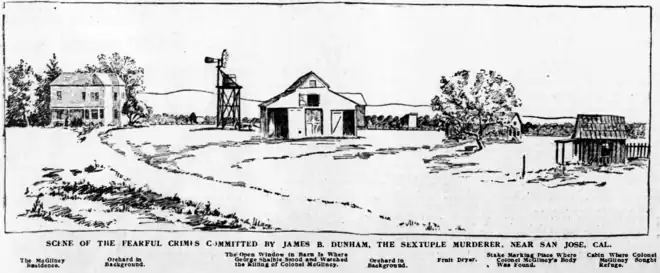
When McGlincy returned with James Wells and Schaible around 11 PM or midnight,[4] McGlincy instructed Schaible to open the barn and throw down some hay for the animals stabled inside. As Schaible was finishing these last chores, he heard gunshots from the main house[3] and hid himself in the hayloft, watching the scenes unfold.[9] After McGlincy had opened the front door, Dunham, lying in wait, had struck him a glancing blow on the head with the ax.[4] Wells, following behind McGlincy, began a short struggle with Dunham that ended when Dunham drew his revolver and slew him with it; the disorder in the entry hall bore mute witness to the ferocity which ceased with the five bullets found in Wells.[3][4] Meanwhile, McGlincy's hat had cushioned the ax blow somewhat, and upon recovering his wits, he ran through the house and escaped through a rear window, shouting for help as he headed towards the barn and a shack where the hired men slept.[3][4]
McGlincy was able to reach the shack and held the door closed before Dunham arrived, calling out "Come out, Mac; come out, I want to see you. ... I am bound to have you, anyhow. Bob [Brisco], come out here; I want you too, and you, too, Schaible."[3] The wounded McGlincy offered a defiant response: "I won't come out, Jim; I have two bullets in me now. Put up your revolver." Dunham fired the revolver blindly twice into the cabin door. As Brisco jumped out the cabin's back window and began running away, Dunham ran off in pursuit and shot him twice; McGlincy took advantage of the brief distraction and started back towards the house, but had made only twenty paces before Dunham returned and killed him with a final shot to the heart.[3]
Survivors
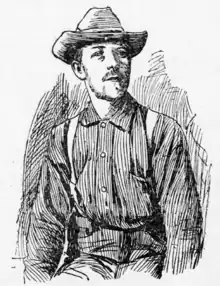
The sole survivors were Dunham's and Hattie's 3-week-old son and a farmhand, George Schaible, who had hidden in the barn during the massacre. Dunham had assumed that Schaible was already resting in the cabin with Brisco, and after checking the cabin for him, entered the barn and ascended the ladder, where Dunham struck a match, looking for Schaible, who was crouched in the hay loft. However, Dunham failed to spot Schaible and left soon afterwards,[3] taking a horse from the barn.[4]
Dunham's motives are unknown. According to an acquaintance of Dunham's, he may have killed everyone in the family to ensure his son would have an uncontested claim to the farm.[13] However, it was discovered later that Col. McGlincy had an unmarried sister working in government service.[14]
Manhunt
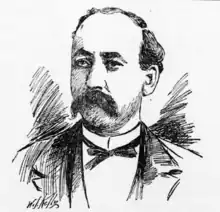
Although investigators conducted an extensive manhunt throughout Santa Clara County, California, Dunham was never found[15] and the case remains officially open.[16] The hunt was fueled by a promised US$11,000 (equivalent to $387,000 in 2022) reward for his capture, dead or alive.[17]
On May 28, he was spotted on the road to Mount Hamilton with a "badly scratched" face and feet inexplicably shod in gunnysacks,[18] but heavy fog prevented his arrest that night.[19] "Patchen", the horse he had stolen from the farm for his escape, was found in Indian Gulch on the morning of May 29, formed by Smith Creek.[20] The manhunt also had found pieces of Dunham's clothing as well as recent campfires.[21] There was evidence that Dunham had broken into a cabin and was still present near Mount Hamilton on May 30.[22] However, because "a shot was distinctly heard shortly after the finding of the horse, and ... no one can be found who fired that shot" and "the buzzards ... keep up their circling over one particular place in [Indian Gulch]" it was thought that Dunham had died by suicide, although his body had not been found.[16]
On June 1, it was reported that Dunham had purchased supplies and the manhunt began anew.[23] A rifle and pistol were stolen from a cabin in Glenwood, giving rise to theories that Dunham had escaped from Mount Hamilton and was continuing south.[24] On June 2, the sheriffs' posse took a train to Hollister, pursuing news overnight that Dunham had been spotted heading for Quién Sabe Valley; they thought he was moving by night and seeking help from Mexican communities that were not aware of his crimes.[25] The next sighting was at Hayes Station on June 4, by a pedestrian who "knew nothing of Dunham, but without being questioned gave them all the details regarding clothes, shoes and hat".[26] At that point, it was believed he was seeking shelter from friends in Tulare County;[27] a rancher near Merced believed he had shared a meal with Dunham,[28] which turned out to be a false accusation.[29]
By June 7, the pursuit was being discontinued;[30] some thought he had never made it as far as Fresno County.[31] It was believed that he effected at least part of his escape via bicycle[32][33] rather than horse, as was common during that time period; Dunham was a long distance cyclist,[21] and a horse believed to be the one he used to make his initial escape, stolen from James Wells, was found a day and a half after the murders.[20][22] A bicyclist matching his description was reported as arriving in Bakersfield on the morning of May 29.[34]
Mysterious fate
Rumors have persisted that he escaped to Cuba[35] or Mexico.[36][37]
Multiple men have been arrested after being misidentified as Dunham. In early June 1896, a man reported as Dunham had asked for food near San Miguel,[38] which turned out to be a different outlaw.[39] Another suspect was arrested in 1897 in Mexico based on a cursory description;[40] he was cleared of suspicion.[41] In 1901, Charles Franklin Crill was arrested in Wichita, Kansas, and brought to San Jose, suspected of being Dunham.[42][43] The next year, Dunham was claimed to be living among the Navajo.[44] After a shootout in Arizona, a man was arrested in September 1904; after being told his wounds were fatal, he confessed to being Dunham.[45] In September 1908, a Texas man was identified as Dunham;[46][47] William Hatfield was brought to San Jose and released in November after a preliminary hearing.[48]
As the trail grew cold, many of the searchers believed he had died by suicide.[16] Skeletal remains have been examined to see if they had come from Dunham, starting in 1898.[49][50] Similar stories followed in the ensuing years, including the discovery of bones in the Pacheco Pass area,[51][52][53] at least one set which disappeared, possibly in hopes of securing the reward.[54] These examinations persisted for at least 40 years.[55]
Several discredited alternate theories have been advanced, postulating that Dunham had been killed to draw the blame from the real murderer(s).[56][57]
Aftermath

The funeral for the four members of the McGlincy-Wells family was held on May 29; one of the floral offerings from the Independent Order of Odd Fellows quoted Romans 12:19: "Vengeance is mine, I will repay, saith the Lord." They were buried at Oak Hill Cemetery[58] in a family plot with Oscar Wells and Robert Brisco; five of the six headstones (all save Oscar's) echo that verse: "Vengeance" (Brisco) "is mine" (McGlincy) "I will repay" (Ada Wells) "saith" (Hattie) "the Lord" (James).[59]
The infant Percy Osborne Brewer (nee Dunham)[60] was adopted by Mrs. M. T. Brewer in San Francisco, a sister of Ada Wells McGlincy.[61]
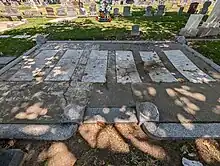
The McGlincy house remained until the 1960s when it was torn down by the owner, Steve Veitenheimer, who owned the last parcel of McGlincy's orchard. The house was approximately where the end of Veitenheimer Lane is today.[1]
References
- Loomis, Patricia (1985). "33: McGlincy Lane". Signposts II. The San [Jose] Historical Museum Association. pp. 62–63. Retrieved 22 February 2023.
- "Baby Dunham's new home". San Francisco Call. June 3, 1896. Retrieved 22 February 2023.
- "Slain with ax and pistol". San Francisco Call. May 28, 1896. Retrieved 22 February 2023.
- "Still at large". San Jose Mercury-News. May 28, 1896. Retrieved 24 February 2023.
- "Dunham a maniac". San Francisco Call. May 28, 1896. Retrieved 22 February 2023.
- "An unprincipled rascal". San Francisco Call. May 28, 1896. Retrieved 22 February 2023.
- "Dunham's bad record". San Francisco Call. May 29, 1896. Retrieved 22 February 2023.
- "Was calmly planned". San Francisco Call. May 29, 1896. Retrieved 22 February 2023.
- Bechdolt, Fred R. (September 28, 1908). "Dunham's Slaughter of McGlincy Family One of Most Cold Blooded Murders". San Francisco Call. Retrieved 23 February 2023.
- "Murdered Six Persons". The Abbeville Press And Banner. 10 June 1896. p. 7. Retrieved 16 July 2017 – via newspapers.com.
- "Records of Deaths: Curious items on the roll at Oak Hill Cemetery". San Jose Mercury-News. March 27, 1900. Retrieved 23 February 2023.
- "Citizens offer gold". San Francisco Call. June 3, 1896. Retrieved 23 February 2023.
- "Dunham's evil temper". San Francisco Call. May 31, 1896. Retrieved 22 February 2023.
- "Col. McGlincy leaves a sister". San Francisco Call. June 18, 1896. Retrieved 22 February 2023.
- "San Jose Death Orgy Recalled by Goins' Slayings". Oakland Tribune. March 19, 1926. Retrieved 27 February 2023.
Dunham rode away on a horse and although a reward was offered for his capture, nothing was ever heard of him.
- "Searching For A Dead Dunham". The San Francisco Call. 1 June 1896. pp. 1, 4. Retrieved 16 July 2017 – via newspapers.com. also https://cdnc.ucr.edu/?a=d&d=SFC18960601.2.3
- "Wanted dead or alive". San Francisco Call. June 4, 1896. Retrieved 23 February 2023.
- "On the trail of murderer Dunham". San Francisco Call. May 29, 1896. Retrieved 22 February 2023.
- "Gave up the search". San Francisco Call. May 29, 1896. Retrieved 22 February 2023.
- "Dunham hiding in the canyons". San Francisco Call. May 30, 1896. Retrieved 22 February 2023.
- crimecapsule (2020-01-04). "1896 Unsolved Murder in California and the lone suspect's surprising escape". Crime Capsule. Retrieved 2022-04-13.
- "Searching in the brush". San Francisco Call. May 31, 1896. Retrieved 22 February 2023.
- "Dunham's trail found again". San Francisco Call. June 2, 1896. Retrieved 22 February 2023.
- "Arms stolen from a ranch". San Francisco Call. June 2, 1896. Retrieved 23 February 2023.
- "Heading for the Quien Sabe". San Francisco Call. June 3, 1896. Retrieved 23 February 2023.
- "Press forward on a new trail". San Francisco Call. June 5, 1896. Retrieved 23 February 2023.
- "Dunham's trail leads southward". San Francisco Call. June 6, 1896. Retrieved 23 February 2023.
- "Dunham seen near Merced". San Francisco Call. June 7, 1896. Retrieved 23 February 2023.
- "Not seen near Merced". San Francisco Call. June 8, 1896. Retrieved 23 February 2023.
- "Dunham's trail has vanished". San Franicsco Call. June 8, 1896. Retrieved 23 February 2023.
- "Not in Fresno County". San Francisco Call. June 9, 1896. Retrieved 23 February 2023.
- "Secreted two bicycles". San Francisco Call. May 31, 1896. Retrieved 22 February 2023.
- "San Joseans not hopeful". San Francisco Call. June 4, 1896. Retrieved 23 February 2023.
- "Is he the demon?". San Francisco Call. May 30, 1896. Retrieved 22 February 2023.
- "Dunham Is Now In Cuba". The San Francisco Call. 16 July 1897. p. 5. Retrieved 16 July 2017 – via newspapers.com.
- "Story of the crime". San Jose Mercury-News. May 1, 1901. Retrieved 22 February 2023.
- "Dunham found again; this time in Mexico". San Jose Mercury-News. June 4, 1911. Retrieved 27 February 2023.
- "Dunham roams near San Miguel". San Francisco Call. June 10, 1896. Retrieved 23 February 2023.
- "Crowley hiding near San Miguel". San Francisco Call. June 11, 1896. Retrieved 23 February 2023.
- "Dunham's Double". San Jose Mercury-News. October 17, 1897. Retrieved 22 February 2023.
- "Not James C. Dunham". San Jose Mercury-News. October 28, 1897. Retrieved 27 February 2023.
- "Murderer Dunham is under arrest". San Jose Mercury-News. May 1, 1901. Retrieved 22 February 2023.
- "Murderer Dunham or his double is a prisoner in San Jose jail". San Francisco Call. May 1, 1901. Retrieved 22 February 2023.
- "He Has Gone After Dunham". Los Angeles Herald. June 4, 1902. Retrieved 27 February 2023.
- "Murderer Dunham is fatally wounded in battle with Rangers". Los Angeles Herald. September 2, 1904. Retrieved 23 February 2023.
- "Find Dunham in Texas". Humboldt Times. Associated Press. September 20, 1908. Retrieved 22 February 2023.
- "Dunham Suspect Is Identified as Murderer". San Francisco Call. September 28, 1908. Retrieved 22 February 2023.
- "Dunham suspect regains freedom". San Francisco Call. November 12, 1908. Retrieved 23 February 2023.
- "Hatching old straw". Morning Tribune. Associated Press. October 13, 1898. Retrieved 27 February 2023.
- "Disappearance of Jas. C. Dunham". Sacramento Record-Union. October 13, 1898. Retrieved 27 February 2023.
- "Search for the Dunham skeleton". San Francisco Call. September 5, 1899. Retrieved 27 February 2023.
- "Not Dunham's skeleton". Stockton Record. August 30, 1900. Retrieved 27 February 2023.
- "Grewsome find in the Pacheco Pass". San Jose Mercury and Herald. January 10, 1904. Retrieved 27 February 2023.
- "Stole a skeleton". Los Angeles Herald. September 24, 1899. Retrieved 27 February 2023.
- "Old skeleton may clear up ancient case". UP. May 5, 1938. Retrieved 22 February 2023.
- "M'Glincy Murder". San Jose Herald. December 7, 1896. Retrieved 22 February 2023.
- "Searching for Dunham's body". San Franicsco Call. April 11, 1897. Retrieved 22 February 2023.
- "Are laid to rest". San Francisco Call. May 30, 1896. Retrieved 22 February 2023.
- Dowd, Katie (February 20, 2023). "The murders behind the most disturbing tombstones in the Bay Area". SF Gate.
- "Baby Dunham's estate". San Francisco Call. June 27, 1896. Retrieved 22 February 2023.
- "His babe adopted". San Francisco Call. May 30, 1896. Retrieved 22 February 2023.
Bibliography
- MacGowan, Douglas (2015). A Silent Man: The Dunham/McGlincy Murders. Self. ISBN 979-8656723893.
- Gilman, Tobin (2018). The McGlincy Killings in Campbell, California. Charleston, South Carolina: The History Press. ISBN 978-1-43966-385-1.
- Terrell, Barney (2021). Cold Wrath: The 1896 Rampage of James C. Dunham. Milwaukee, Wisconsin: Genius Books. ISBN 9781947521698.
External links
- https://web.archive.org/web/20150209235839/http://www.crimelibrary.com/notorious_murders/family/mcglincy_massacre/index.html Full article on Court TV's The Crime Library]
- Stoltz, Eric (February 17, 2009). "Vengeance is the Lord's: James C. Dunham (~1865-?)". Stoltz Family Genealogy.
- "McGlincy Massacre Tour". Campbell Historical Museum & Ainsley House.